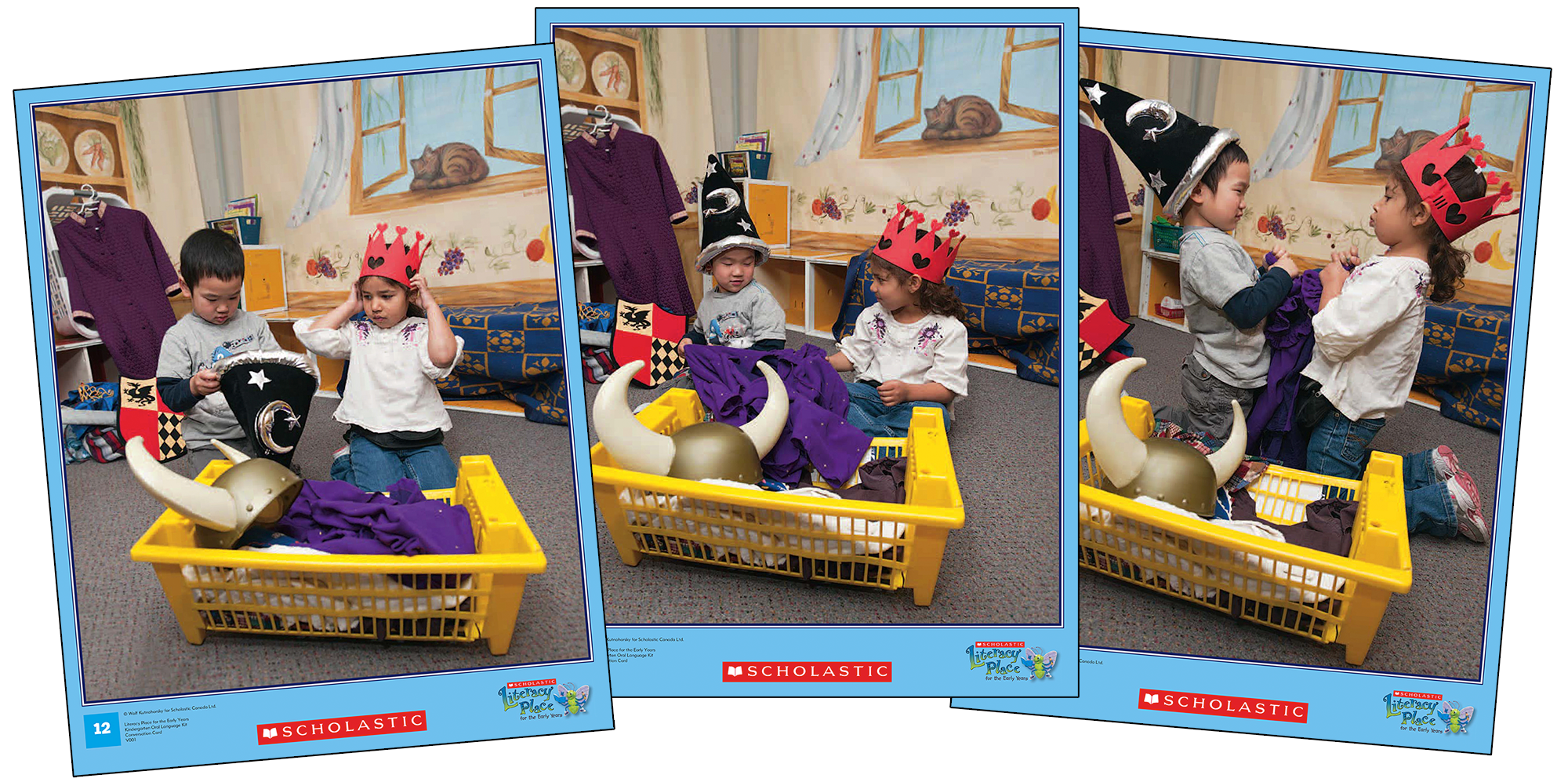Summary: These three cards depict two children playing dress up. The boy and girl have chosen different items to wear on their heads. Both children then select the same purple cloak to wear and neither of them will let it go.
Oral Language Teaching Strategy:
Connect with the Student’s Message Listen and respond to the meaning behind the student’s communication.
Time: one 30-minute lesson or two 15-minute lessons
Materials: Sequence Cards #12, 13, 14
Grouping: whole class or small group
Assessment: Kindergarten Oral Language Assessment Scale
FOCUSING ON THE PICTURE
[Analyzing/inferring]- Have students sit in a circle and display the three cards prominently, in random order, so all students can see (for example, along the ledge of the chalkboard).
Today I have three pictures to show you. These pictures are connected and tell a story. As you look closely at the pictures, think about the order they should go in. What story do you think the pictures are trying to tell us?
Provide ample time for students to analyze the pictures, providing prompts to deepen their observations.
- After students have had an opportunity to examine the pictures on the sequence cards, group the students in Popsicle-stick partners. (Each student’s name is written on a Popsicle stick. The Popsicle sticks are put in a jar and two are pulled at a time, creating partners.) Have students talk to their partners about what they notice about the pictures.
- Offer prompts to stimulate discussion:
- Who do you think the children in these pictures are?
- How do you think the children know each other?
- What is happening in each picture?
- What clues can we use to figure out what is happening in these pictures?
- What story do you think is being told?
Why do you think John and Joy thought the pictures appeared in this order? Remember to use your words so everyone hears your great thinking. Thank you for sharing your thinking, Piper. I understand that one group had a different order. Did this make you rethink the order that you put the pictures in? Why or why not?
Provide time for partners to talk about the pictures and the order of the sequence cards. Ask for a volunteer to state the order the sequence cards should appear in. Then ask anyone who had a different order to share it with the class.
- As a group, decide on the order of the sequence cards and have students
share their reasoning. Remember to focus on the students’ meaning as they share their thinking and paraphrase if necessary to confirm their meaning.
Teaching Tip: This teaching plan offers an opportunity to focus on concepts about time in mathematics. Using ordinal numbers can be a fun and hands-on way to reinforce vocabulary across the curriculum.
GOING DEEPER
[Inferring/evaluating]Now that we have decided on an order to the pictures, we can brainstorm a name for our pictures. What do you think the person who took these pictures wanted us to see?
- As a group decide on the order of the sequence cards and have students share their reasoning. Remember to focus on the students’ meaning as they share their thinking and paraphrase if necessary to confirm their meaning.
- Offer open-ended prompts that focus the students on the emotions portrayed:
- Let’s take a closer look at the boy in these pictures. How is he feeling in the first picture (the second picture/the third picture What clues tell you this?
- Look closely at the boy’s face. How do his feelings change in each picture?
- Now let’s take a closer look at the girl in these pictures. How is she feeling in the first picture (the second picture/the third picture)? What clues tell you this?
- Look closely at the girl’s face. How do her feelings change in each picture?
- Why do you think both children want the purple cloak?
- What do you think the children are saying to each other as they are tugging at the cloak?
Sam: I think he fight not share.
Teacher: Do you mean you think the boy is fighting and not sharing? Would anyone like to add on to Sam’s great thinking?
-
I’m going to pretend to be the boy and say, “Hey, I want the purple cloak. I need it to be a wizard!” If you pretend to be the girl what would you say? How would you say it? Would you say it in a happy voice or a mad voice?
Role play the problem depicted in the sequence cards by taking the part of one character and inviting a student to take on the role of the other child.
- Once you have practised acting out the parts together, ask students to role play the conversation between the girl and boy with their partners.
You may conclude the lesson at this point and do the second part on the next day, or you may decide to continue and do Connecting and Predicting as part of the first lesson.
CONNECTING
Teaching Tip: If you decide to do Connecting and Predicting on the second day, begin your lesson by reviewing the pictures with the students.
Making connections]
- Have students connect their personal experiences with the emotions and interactions in the pictures. Prompts might include:
- Do you think it is important to share? Why?
- How does it feel when you fight with your friends? Would you like to feel this way?
- Are there better ways to solve this situation than a ‘tug of war’?
-
Have you ever fought over something with your friend? How did it feel? How did you work it out with your friend?
Offer specific prompts that fit the discussion you have had with the group.
PREDICTING
[Predicting]-
What do you think will happen next? Why do you think this? How might the boy and girl solve their problem?
Ask students to think about what could happen after the picture shown on Sequence Card 14.
LESSON EXTENSIONS
-
Use the focus of the pictures (sharing) as a basis for a shared writing lesson. Create a chart about sharing and collaborate with students on building two to three sentences about sharing.
-
Create a simple readers’ theatre script with the students about the pictures shown on the sequence cards. Then have students practise reading the script.
FOLLOW-UP IN CENTRES
-
Provide students with a variety of puppets and Sequence Cards # 12, 13, and 14. Students can use the puppets retell the story as they practise their problem solving skills for situations like the one depicted. Try to reinforce the idea of sharing.
-
Provide students with felt characters and costumes to use on the flannel board where they can act out stories involving sharing.
-
Place a limited number of toys (fewer than the number of students at the centre) to use at the water and/or sand centre and encourage students to work out ways to share these toys fairly.

